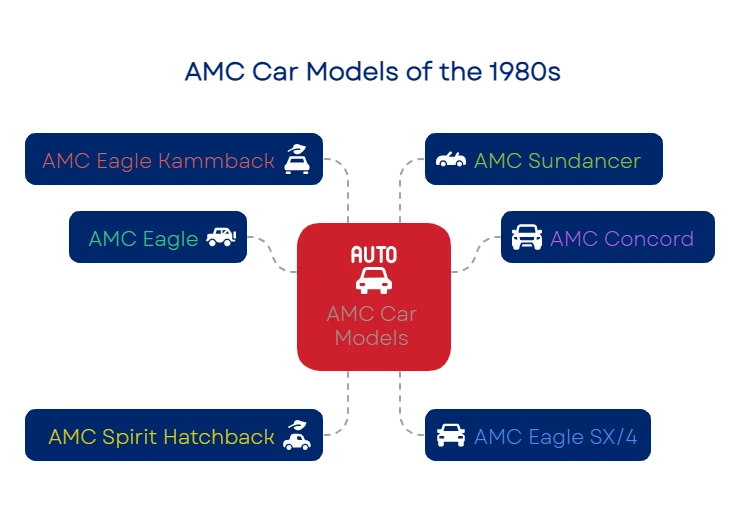American Motors Corporation (AMC) made cars that were unlike anything else on the road. While other brands followed the same formula, AMC pushed the limits of design, capability, and innovation. This continued through the final years of the company.
By the start of the decade, AMC was already in a tough spot. General Motors, Ford, and Chrysler had massive production capacity. Imported cars from Japan and Europe were flooding the U.S. market.
Instead of copying what others were doing, AMC took a different approach. It introduced models like the AMC Eagle, which combined four-wheel drive capability with the comfort of a sedan. The company also improved its compact car lineup and offered features usually found in larger vehicles. These included power steering, rear window defrosters, and other standard features.
These choices helped AMC’s lineup stand out. Today, collectors and vintage car buyers see many AMC vehicles as valuable pieces of American history. Cars that were once ignored are now showing up at car shows and auctions across the country.
If you're planning to buy or ship one of these cars, or you're interested in how AMC helped shape the automotive industry, you're in the right place. This article covers the most memorable AMC models from the 1980s, why they mattered, and what makes them worth a second look today.
What You'll Learn
Which 1980s AMC cars left a lasting mark and why they're still talked about today
What led to the fall of American Motors Corporation by the end of the decade
Which AMC vehicles from the decade are catching the eyes of collectors and classic car buyers right now
Overview
This article explores the unique and iconic 1980s AMC cars, highlighting models known for their innovative designs and features that set them apart from other American automobiles of the time. The most relevant information will depend on whether someone is a collector, potential buyer, or simply interested in automotive history.
Here's a more detailed breakdown:
Standout AMC Models of the 1980s
This covers the key AMC vehicles of the decade, detailing models like the AMC Eagle, Concord, and Spirit, and their distinctive features such as four-wheel drive capabilities and unique body styles.
Strategic Innovations and Design Philosophy
This section explains how AMC, operating with limited resources, focused on innovations such as introducing the first four-wheel drive passenger car to stand out in the market.
The Decline of AMC and the End of Production
This outlines the reasons behind the struggles and eventual end of American Motors Corporation, including competition from imported cars, limited resources, and increasing federal regulations.
1980s AMC Cars Worth Collecting Today
This focuses on the AMC models that are now sought after by collectors, highlighting their value, unique engineering, and limited production, such as the AMC Eagle and SX/4.
Other Notable Aspects
Transporting 1980s AMC Cars
This briefly mentions services like AmeriFreight Car Shipping that assist with the transportation of these classic vehicles, which is particularly useful for collectors and buyers.
Standout AMC models of the 1980s
During the decade, American Motors Corporation offered a lineup that focused on compact size, off-road capability, and practical design. These AMC cars stood out in a crowded field of passenger cars by offering something different. Many are now seen as collectible vehicles.
AMC Eagle
The AMC Eagle was one of the first American passenger cars with four-wheel drive. It helped define what would later become the crossover SUV category. The Eagle was built for comfort and light off-road use. It performed well on snow and gravel, which gave it strong appeal in rural and northern states.
Specs (1980–1987):
Engine options: 4.2L inline-six or 2.5L four-cylinder
Transmissions: 4-speed manual or 3-speed automatic
Horsepower: 100 to 112
Drivetrain: Selectable four wheel drive
Fuel economy: Up to 20 city, 28 highway
Body styles included wagon, sedan, SX/4 coupe
Weight: Around 3,200 to 3,500 pounds
AMC Concord
The AMC Concord was aimed at drivers who wanted a midsize car with a comfortable ride. It shared its chassis with the Eagle but used rear-wheel drive. It came in multiple body styles and offered premium trim levels.
Specs (1980–1983):
Engine options: 2.5L four-cylinder or 4.2L inline-six
Transmissions: 3-speed automatic or 4-speed manual
Horsepower: 86 to 112
Fuel economy: Up to 24 highway
Available as a sedan, coupe, and station wagon
Common features included power steering, rear window defroster, and cloth seating
AMC Spirit Hatchback
The AMC Spirit was a compact car that appealed to budget-conscious buyers. It was lightweight, affordable, and came with styling upgrades in sport trim levels.
Specs (1980–1983):
Engine options: 2.0L Audi four-cylinder, 2.5L AMC four-cylinder, or 4.2L inline-six
Transmissions: 3-speed automatic or 4-speed manual
Horsepower: 80 to 112
Fuel economy: Up to 30 highway
Available as a 2-door hatchback or sedan
Popular options included rally striping and sport trim
AMC Eagle SX/4
The SX/4 was a two-door version of the Eagle that looked and felt more like a small sports car. It had the same four wheel drive system but was more compact and aimed at younger drivers.
Specs (1981–1983):
Engine options: 2.5L or 4.2L inline-six
Transmissions: 4-speed manual or 3-speed automatic
Horsepower: 82 to 115
Fuel economy: Up to 24 highway
Only available as a 2-door fastback
Optional features included alloy wheels and sport interior trim
AMC Eagle Kammback
The Eagle Kammback was a hatchback version of the Eagle, produced in low numbers. It kept the four wheel drive capability but came in a shorter, more city-friendly body.
Specs (1981–1982):
Engine: 2.5L inline-four
Transmissions: 4-speed manual or 3-speed automatic
Horsepower: About 84
Fuel economy: Around 23 mpg combined
Offered as a 2-door hatchback
Low production makes it rare today
AMC Sundancer
AMC did not release factory-built convertibles during the 1980s, but a few were created by third-party shops or dealers. Most were based on the Concord or Eagle platforms. These are now collector curiosities due to their limited numbers.
Strategic innovations and design philosophy
American Motors Corporation operated on a smaller budget than companies like General Motors or the Chrysler Corporation. This forced AMC to think differently. Instead of trying to compete with full-size sedans or large trucks, AMC focused on compact car platforms, four wheel drive capability, and practical upgrades across its passenger cars.
AMC’s approach was shaped by its history. Born from the 1954 merger of the Nash Kelvinator Corporation and Hudson Motor Car Company, American Motors had always been an underdog. By the 1980s, AMC sought to build smart, fuel-efficient cars that met changing customer needs without copying imported cars.
Their goal was simple: offer value, meet safety regulations, and create cars that stood out at car shows or in daily traffic.
AMC’s innovations during this time helped reshape what people expected from American cars. These ideas led to models like the 1980 AMC Eagle and influenced what we now call the crossover SUV.
Key innovations from AMC in the 1980s:
First U.S. four-wheel drive passenger car: The AMC Eagle combined a car body with a four wheel drive system. It could handle snow, gravel, and dirt, which made it popular in cold or rural areas.
Multiple body styles, one platform: AMC reused the same chassis across different vehicles like the Eagle, SX 4, and Concord. This saved money and made repairs easier for owners.
Comfort-focused features as standard equipment: Many AMC vehicles included features such as power steering, rear window defrosters, and tilt steering columns as part of the base trim.
Better fuel economy across AMC’s lineup: Smaller engines and lighter builds helped models like the Spirit and Concord deliver better gas mileage than many other cars at the time.
Creative off-road options: AMC added raised suspensions, extra clearance, and rugged wheels to models like the Eagle SX 4. These vehicles performed like light trucks but drove like cars.
The company’s Renault partnership also brought European ideas to the table. Renault focused on efficiency and small-car design. This helped AMC refine its compact car lineup and bring in fresh thinking during a tough time in the automotive industry.
The Decline of AMC and the End of Production
By the mid-1980s, American Motors Corporation was losing ground. Despite building some of the most forward-thinking passenger cars of the time, AMC could not keep pace with the larger players in the automotive industry.
Why American Motors struggled in its final years:
Limited resources
AMC had far fewer production plants than General Motors or the Chrysler Corporation. This made it harder to develop new AMC models or modernize existing ones like the AMC Concord and AMC Pacer.Imported cars gained ground
Compact, fuel-efficient vehicles from Japan and Europe were winning over U.S. buyers. AMC sought to compete, but rising costs and limited production capacity slowed its progress.Narrow lineup of AMC vehicles
While cars like the AMC Eagle wagon, SX/4, and station wagon variations had their fans, the lineup lacked volume. That left AMC more vulnerable to market swings.Increasing federal regulations
Meeting changing safety regulations and emissions rules added extra pressure. Unlike larger brands, AMC had fewer models to spread these costs across.Falling sales and limited reinvestment
With sales dropping, there was less money for updates, quality control improvements, or promotions. Even standout features like four-wheel drive and better fuel economy couldn’t make up for the decline in volume.
In 1987, the Chrysler Corporation bought AMC. The deal focused on acquiring Jeep, which included earlier partnerships like the Kaiser Jeep and what would later become the XJ Cherokee and Grand Wagoneer. After the sale, production of AMC cars stopped. The company’s stock vanished, and the company name was retired.
Even though American Motors ceased operations, its impact lives on. The 1980 AMC Eagle is now seen by many as the blueprint for the modern crossover SUV. Indeed, that four-wheel drive system in a compact car body was rare at the time. Today, the crossover SUV concept is standard across many brands.
1980s AMC Cars Worth Collecting Today
Many 1980s AMC vehicles were once overlooked. Now, these same models are showing up at car shows and classic auctions across the country. Their value is growing thanks to their unique engineering, limited production, and early features that are common in today’s vehicles.
The AMC Eagle remains the best-known collector model from this era, but it's not the only one worth paying attention to.
Popular 1980s AMC cars among collectors:
1980 AMC Eagle
One of the first crossover SUV concepts ever made. It used a four-wheel drive system on a car platform and offered high ground clearance, making it one of the few passenger cars that could also be used like light trucks.Fuel economy: up to 28 mpg highway
Body styles: Eagle wagon, Eagle sedans, SX/4 coupe
Common upgrades included power steering, rear window defroster, and upgraded trims
AMC Concord
This mid size station wagon, coupe, and sedan became known for comfort and reliability. Because many used the same chassis as the Eagle, replacement parts are easier to find.Best known for smooth suspension and simple repairs
Often included standard equipment like tilt steering columns and cloth seats
Eagle SX 4
A sportier version of the Eagle with a compact two-door layout. This model was a favorite among drivers who needed winter traction but didn’t want a full-size SUV.Great for snowy or uneven roads
Increasing demand due to low production numbers
AMC Pacer
Known for its round shape and wide windshield, the Pacer is popular for its quirky design. Though polarizing, it has grown in value in recent years.Often modified with new paint or interior parts
Limited numbers still running today
AMC Gremlin, AMC Hornet, and AMC Javelin
While mostly known as 1970s models, a few versions of these cars were still on the road in the early 1980s. Some received minor updates and were passed on as used cars through AMC dealerships.The AMC Gremlin stood out as a two-door compact car.
The AMC Javelin remained a well-known pony car with a strong collector base.
The AMC Hornet served as the foundation for multiple body styles and later influenced the development of the Concord.
If you’re thinking about moving one of these classics, understanding how to transport it properly is just as important. Learn more from this guide on transporting your classic car.
Why collectors seek 1980s AMC vehicles
AMC’s history, from the Nash Kelvinator Corporation and Hudson Motor Car Company to the Chrysler Corporation merger, tells the story of a company that often moved ahead of its time.
AMC sought to meet real-world needs with:
All-weather cars using a four wheel drive system
Strong fuel economy for a decade defined by gas concerns
Compact car dimensions with options suitable for families, off-road use, and daily driving
Body styles that ranged from wagons to hatchbacks, helping buyers choose function over flash
Final Thoughts
Many AMC vehicles from the 1980s offered features that were rare at the time, like power steering, rear window defrosters, and even early forms of all wheel control. These features were often included as standard equipment rather than costly upgrades.
Their build quality and shared components, such as the use of the same chassis across models, make repairs easier today. Their odd shapes, unique colors, and clear break from traditional American cars also make them stand out at shows.
If you come across a clean 1980 AMC Eagle wagon or an Eagle SX 4 with original body panels, you may be looking at a car that collectors will keep watching for years to come.
Transporting 1980s AMC Cars With AmeriFreight Car Shipping
Whether you're buying, selling, or restoring a 1980s AMC car, AmeriFreight Car Shipping is here to help make your car shipping experience a breeze. We’ll coordinate safe and reliable transportation right to your door.
Contact our team to learn more about open and enclosed transport options, and get a free quote today. Let us take the stress out of shipping your classic car!
Frequently Asked Questions (FAQs)
What kind of cars did AMC make?
American Motors Corporation produced compact car models, mid size sedans, station wagons, and four wheel drive passenger cars. Popular AMC vehicles included the AMC Eagle, Concord, Spirit, and Pacer.
How much horsepower does a 1985 AMC Eagle have?
The 1985 AMC Eagle with a 4.2L inline-six engine produced approximately 112 horsepower. Lower trims with a 2.5L engine had about 100 horsepower.
What was the last AMC car made?
The last AMC car produced was the 1988 Eagle wagon, built after the Chrysler Corporation acquisition. It marked the end of American Motors stock and nameplate production.
What were the AMC models in 1981?
AMC’s 1981 lineup included the AMC Eagle, AMC Concord, AMC Spirit, and Eagle SX 4. Specialty models like the AMC Eagle Kammback and various body styles were also offered that year.




















